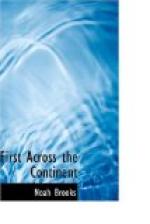It is noticeable that the explorers, all along their route, gave to streams, rocks, mountains, and other natural features of the country many names that appear to us meaningless and trifling. It would appear that they used up all the big names, such as Jefferson, Gallatin, Philosophy, Philanthropy, and the like, and were compelled to use, first, the names of their own party, and then such titles as were suggested by trifling incidents. For example, when they reached a difficult shoal on the Yellowstone River, they named that Buffalo Shoal because they found a buffalo on it; and Buffalo Shoal it remains unto this day. In like manner, when they reached a dangerous rapid, twenty miles below that point, they saw a bear standing on a rock in the stream; and Bear Rapid the place was and is named. Bear and buffalo were pretty numerous all the way along that part of the river which they navigated in July. They had now rejoined the boats, and on the last day of July, when camped at a point two miles above Wolf Rapid (so called from seeing a wolf there), the buffalo were continually prowling about the camp at night, exciting much alarm lest they should trample on the boats and ruin them. In those days, buffalo were so numerous that they were a nuisance to travellers; and they were so free from fear of man that they were too familiar with the camps and equipage. On the first of August we find this entry in the journal of the party:—
“The buffalo now appear in vast numbers. A herd happened to be on their way across the river. Such was the multitude of these animals that, though the river, including an island over which they passed, was a mile wide, the herd stretched, as thickly as they could swim, from one side to the other, and the party was obliged to stop for an hour. They consoled themselves for the delay by killing four of the herd; and then having proceeded for the distance of forty-five miles (in all to-day) to an island, below which two other herds of buffalo, as numerous as the first, soon after crossed the river.”
Again, on the very next day, we find this entry:—
“The river was now about a mile wide, less rapid, and more divided by islands, and bars of sand and mud, than heretofore; the low grounds, too, were more extensive, and contained a greater quantity of cottonwood, ash, and willows. On the northwest was a low, level plain, and on the southeast some rugged hills, on which we saw, without being able to approach them, some bighorns. Buffalo and elk, as well as their pursuers, the wolves, were in great numbers. On each side of the river there were several dry beds of streams, but the only one of any considerable size was one to which they gave the name of Ibex River, on the right, about thirty yards wide, and sixteen miles from their encampment of the preceding night. The bear, which had given them so much trouble at the head of the Missouri, they found equally fierce here. One of these animals, which was on a sand-bar




